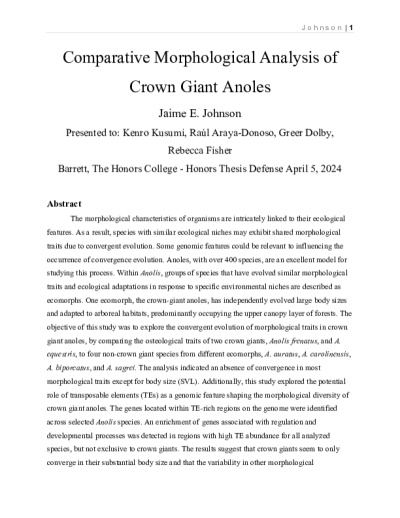Filtering by
- All Subjects: Evolution
- Creators: Kusumi, Kenro
- Creators: Compton, Zachary


Cancer rates vary between people, between cultures, and between tissue types, driven by clinically relevant distinctions in the risk factors that lead to different cancer types. Despite the importance of cancer location in human health, little is known about tissue-specific cancers in non-human animals. We can gain significant insight into how evolutionary history has shaped mechanisms of cancer suppression by examining how life history traits impact cancer susceptibility across species. Here, we perform multi-level analysis to test how species-level life history strategies are associated with differences in neoplasia prevalence, and apply this to mammary neoplasia within mammals. We propose that the same patterns of cancer prevalence that have been reported across species will be maintained at the tissue-specific level. We used a combination of factor analysis and phylogenetic regression on 13 life history traits across 90 mammalian species to determine the correlation between a life history trait and how it relates to mammary neoplasia prevalence. The factor analysis presented ways to calculate quantifiable underlying factors that contribute to covariance of entangled life history variables. A greater risk of mammary neoplasia was found to be correlated most significantly with shorter gestation length. With this analysis, a framework is provided for how different life history modalities can influence cancer vulnerability. Additionally, statistical methods developed for this project present a framework for future comparative oncology studies and have the potential for many diverse applications.
Agassiz’s desert tortoise (Gopherus agassizii) is a long-lived species native to the Mojave Desert and is listed as threatened under the US Endangered Species Act. To aid conservation efforts for preserving the genetic diversity of this species, we generated a whole genome reference sequence with an annotation based on deep transcriptome sequences of adult skeletal muscle, lung, brain, and blood. The draft genome assembly for G. agassizii has a scaffold N50 length of 252 kbp and a total length of 2.4 Gbp. Genome annotation reveals 20,172 protein-coding genes in the G. agassizii assembly, and that gene structure is more similar to chicken than other turtles. We provide a series of comparative analyses demonstrating (1) that turtles are among the slowest-evolving genome-enabled reptiles, (2) amino acid changes in genes controlling desert tortoise traits such as shell development, longevity and osmoregulation, and (3) fixed variants across the Gopherus species complex in genes related to desert adaptations, including circadian rhythm and innate immune response. This G. agassizii genome reference and annotation is the first such resource for any tortoise, and will serve as a foundation for future analysis of the genetic basis of adaptations to the desert environment, allow for investigation into genomic factors affecting tortoise health, disease and longevity, and serve as a valuable resource for additional studies in this species complex.
Data Availability: All genomic and transcriptomic sequence files are available from the NIH-NCBI BioProject database (accession numbers PRJNA352725, PRJNA352726, and PRJNA281763). All genome assembly, transcriptome assembly, predicted protein, transcript, genome annotation, repeatmasker, phylogenetic trees, .vcf and GO enrichment files are available on Harvard Dataverse (doi:10.7910/DVN/EH2S9K).


Cooperative cellular phenotypes are universal across multicellular life. Division of labor, regulated proliferation, and controlled cell death are essential in the maintenance of a multicellular body. Breakdowns in these cooperative phenotypes are foundational in understanding the initiation and progression of neoplastic diseases, such as cancer. Cooperative cellular phenotypes are straightforward to characterize in extant species but the selective pressures that drove their emergence at the transition(s) to multicellularity have yet to be fully characterized. Here we seek to understand how a dynamic environment shaped the emergence of two mechanisms of regulated cell survival: apoptosis and senescence. We developed an agent-based model to test the time to extinction or stability in each of these phenotypes across three levels of stochastic environments.


Cancers of the reproductive tissues make up a significant portion of the cancer burden and mortality experienced by humans. Humans experience several proximal causative carcinogens that explain a portion of cancer risk, but an evolutionary viewpoint can provide a unique lens into the ultimate causes of reproductive cancer vulnerabilities. A life history framework allows us to make predictions on cancer prevalence based on a species’ tempo of reproduction. Moreover, certain variations in the susceptibility and prevalence of cancer may emerge due to evolutionary trade-offs between reproduction and somatic maintenance. For example, such trade-offs could involve the demand for rapid proliferation of cells in reproductive tissues that arises with reproductive events. In this study, I compiled reproductive cancer prevalence for 158 mammalian species and modeled the predictive power of 13 life history traits on the patterns of cancer prevalence we observed, such as Peto’s Paradox or slow-fast life history strategies. We predicted that fast-life history strategists will exhibit higher neoplasia prevalence risk due to reproductive trade-offs. Furthering this analytical framework can aid in predicting cancer rates and stratifying cancer risk across the tree of life.